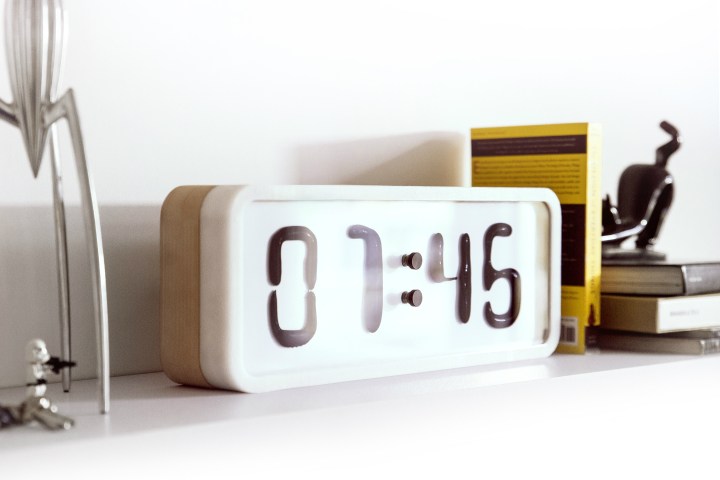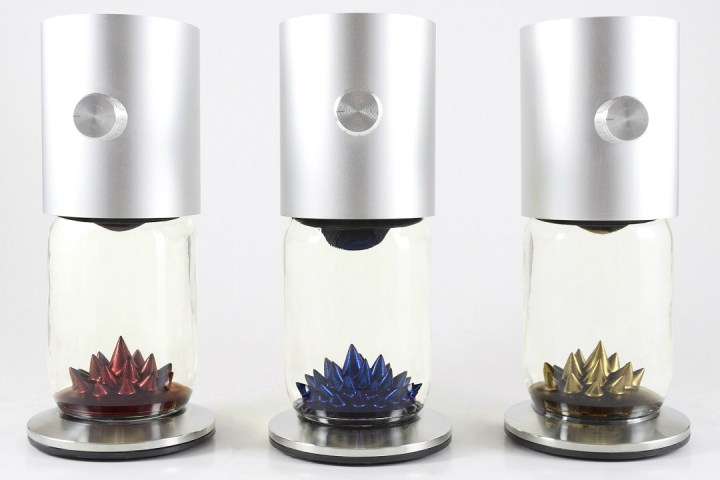Ferrofluid is mesmerizing to behold. It has the fluid properties of a liquid and also the magnetic properties of a solid state of matter. The term itself is a portmanteau of “ferromagnetic” and “fluid.” This is because ferrofluid is made up of microscopic magnetic solids suspended in a liquid form.
Ferrofluids were originally created by NASA to better control liquids (namely rocket fuel) in zero gravity. Combined with rocket fuel, ferrofluids can be easily controlled and directed towards a pump via a magnetic field. Of course, most of us non-spacefaring humans won’t be using the stuff to power a rocket anytime soon, but luckily we can still enjoy the material’s incredible properties via a multitude of spellbinding ferrofluid gadgets.
So without further ado, here are seven of the coolest ferrofluid gizmos that money can buy.
Ferrolic clock
Most clocks are woefully utilitarian. They serve but one purpose: illustrating the passing moments of our fleeting existence. The Ferrolic clock, designed by Zelf Koelman , utilizes a ferrofluid screen to more aptly display these ephemeral moments.
The Thinker

Sometimes the slightest distraction is the best ways to get the ol’ cognitive cogs turning. This is where The Thinker by Inspired Designs comes into play. Unlike some of the bulkier ferrofluid desktop items out there, The Thinker uses a compact, elegant design that can be easily stored in a drawer rather than being perpetually displayed.
Ferrofluid lamp

The Ferrofluid Lamp is another product from Inspired Designs . The 450 milliliter tube uses a bulb similar to a lava lamp enabling the ferrofluid to rise and fall. The lamp also comes with magnets so you can manipulate the ferrofluid via magnetic field as well.
zKULL

The zKull is a product from Concept Zero . If at first glance you thought the zKull was oddly similar to Dan Aykroyd’s Crystal Skull Vodka bottles, you weren’t mistaken. For some reason, the company uses Crystal Skull Vodka bottles filled with water (not vodka — sorry) and ferrofluid. You can choose from black, blue, or gold colored ferrofluid. So metal…
RIZE Spinning Ferrofluid Display

The RIZE is another smaller ferrofluid gadget perfect for a desktop. A black screw is positioned in the middle of the glass display and acts as the magnetic conduit for the sculpture. Once the vial is placed on the magnetic base, the magnetic field causes the ferrofluid to spin around the groves of the screw. The Rize is available with gold, red, blue, or purple ferrofluid.
Rhei clock

The Rhei clock is another solid ferrofluid clock. Like the Ferrolic clock, the Rhei uses a ferrofluid display and a series of internal magnets to display the time. While the Ferrolic has a rather clunky metal housing, the Rhei features a wooden back, clean lines, and rounded edges for a more low-profile, modern look.
Ferroflow

The Ferroflow is similar to The Rize, albeit on a much larger scale. The Ferroflow uses magnets inside of the stainless steel base and also on top of the glass display to activate the ferrofluid inside. You can also manually manipulate the fluid using Rize’s detachable neodymium magnet.


